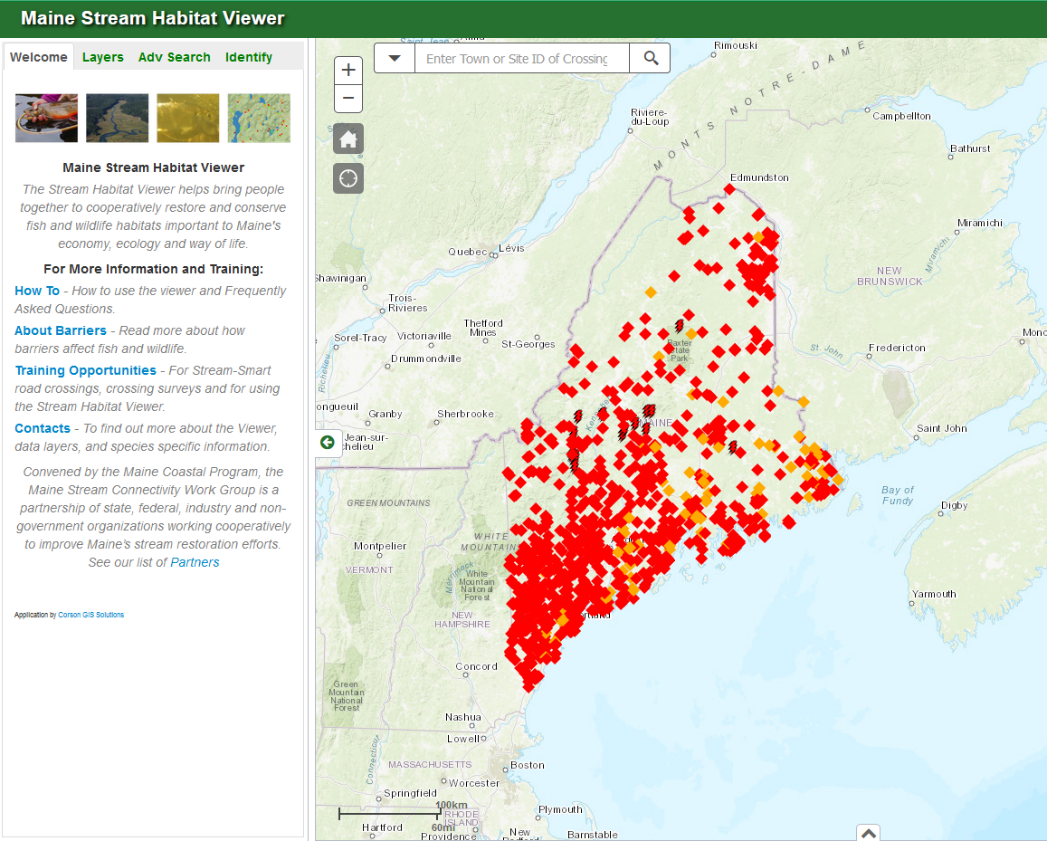In this Issue:
Beginning with Habitat equips Maine communities, landowners, and conservation partners with tools to protect, restore, and connect high-value ecosystems in a changing climate. Housed within Maine Department of Inland Fisheries and Wildlife, Beginning with Habitat staff work with species experts, ecologists, and conservation partners to translate biodiversity information into conservation action at both a local and statewide scale (beginningwithhabitat.org).
In conversations with, colleagues, friends, neighbors and loved ones, it is clear that the effects of unusual weather patterns and high temperatures are being felt in all our daily lives. The extreme storms that occurred in December and January, the thin and hazardous ice, the first-ever cancellation of the Can-Am dog race, and the summer-like weather in February have all made it impossible to ignore the effects of climate change in Maine.
Climate change impacts are concerning for Maine’s natural landscapes and the vitality and resilience of our communities. Planning for and adapting to our changing climate is necessary to Maine and its natural heritage. At the Beginning with Habitat program, we are excited to work with our network of partners to share information, map resources, and implement strategies to steward Maine’s species and habitats into the future . The ongoing work we and our network are doing is comprehensive and includes engaging with municipalities and land trusts on conservation and resilience planning, coordinating climate change initiatives, map display and spatial data dissemination, and advising on habitat management strategies. See below “Showcasing BwH” in action to learn about Sarah Haggerty’s important work utilizing the Stream Habitat Viewer!
We are also thrilled about several new initiatives:
In partnership with Maine Natural Areas Program, we are planning to release a new dataset of Focus Areas of Statewide Ecological significance in the next year. Focus Areas are important concentrations of at-risk species of plant and animal habitats and are vital nodes of biodiversity in Maine. Accompanying this spatial resource will be detailed descriptions and appropriate conservation strategies for these sites.
In partnership with Maine Geospatial Institute (MGI), BwH is recruiting a Geospatial Intern for the summer. Please share this opportunity with aspiring GIS professionals looking for conservation-oriented career experience within the University of Maine system.
We hope to engage you in our work!
Sincerely,
Justin Schlawin
Program Coordinator
(207) 557-1885
BwH staff left to right: Corinne Michaud-LeBlanc, Joe Roy, Justin Schlawin, Amy Dowley
Beginning with Habitat is excited about this new communication platform to help us connect with you - our partners and users. Looking ahead, we plan to circulate our newsletters twice a year, in April and then again in October.
We will use this space to post about events, current projects, funding opportunities and updates related to our services and data sharing. We also want to highlight BwH in action as a way to provide examples of how Mainers are leveraging our products and services to support conservation work across the state.
Reaching out for your ideas and contributions
We would like to hear from you! For future newsletters, we want to share stories from our partners and users. How have you been using BwH in your conservation planning efforts? We are looking for case studies showing examples of BwH in action. Please reach out directly to justin.schlawin@maine.gov with your stories.
Stream Habitat Viewer Driving Community Stream Habitat Restoration

Sarah Haggerty, Conservation and GIS Manager at Maine Audubon, is championing Beginning with Habitat tools to help Maine communities restore aquatic habitat. Sarah hosts municipal workshops to demonstrate how to utilize the Maine Stream Habitat Viewer to prioritize road/stream crossings and apply for grant funding that offsets the cost of creating larger Stream Smart crossings.
The Stream Habitat Viewer provides information on road/stream crossings that obstruct fish and wildlife passage, and it does so in a very user-friendly way. With a "stoplight" approach, crossings are color-coded as red, yellow, or green dots showing which crossings are barriers, potential barriers, or not barriers to fish movements. Layers that display a variety of fish and wildlife habitats and handy pop-ups filled with information make this a simple and important tool for working with municipalities to identify undersized road/stream crossings that are causing problems for wildlife and that could be eligible for funding.
|

The Beginning with Habitat team is available for free in-person and remote presentations. Potential topics include information about high value wildlife habitat, habitat management guidance, climate resilience and conservation strategies to support community priorities. We would look forward to connecting with you and your committee or organization.
Access Beginning with Habitat services using our online request form:
- Large, printed maps
- GIS data package
- In-person and remote presentations
Check out the BWH Map Viewer to create your own custom maps.
The Maine Won’t Wait Climate Council has identified the goal of conserving 30% of land by 2030. As noted in the Maine Won't Wait Climate Action Dashboard, Maine's conserved lands include private conservation easements, state parks, federal wildlife reserves and more. As of November 2023, 22.2% of Maine's land area is conserved.
The Conserved Lands dataset is the vehicle for measuring our progress toward the state’s goal. Conservation advocates across the state provide voluntary updates to the dataset, which ensures that we maintain a relevant and accurate database. Join us in the effort to track and achieve our climate action goals. Please reach out to amy.dowley@maine.gov and learn how to contribute updates to the Conserved Lands dataset.
|